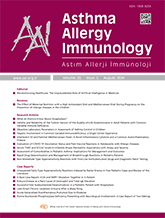


Acute generalized exanthematous pustulosis (AGEP) is a sudden-onset, severe and rare adverse skin reaction characterized by nonfollicular sterile pustules tending to intertriginous localization. Lesions develop on erythematous and edematous skin. It is often triggered by drugs. This article presents a case diagnosed with AGEP due to etodolac. To the best of our knowledge, this is the second case of AGEP due to etodolac in the literature.
A 47-year-old female patient presented with diffuse erythema on the extremities, a purple purpuric rash on the extensor face of both legs, and millimetric pustules on an erythematous base on the inner surface of the left arm. She stated that the reaction developed after taking 3 medications, including etodolac tablets, and gargling the throat with povidone-iodine.
The patient was diagnosed with AGEP and her EuroSCAR AGEP Validation Score was calculated as 9 suggesting a definitive diagnosis of AGEP. All of the suspected drugs were discontinued. Methylprednisolone 16 mg/day, a local corticosteroid, and an oral antihistamine were started. Her symptoms resolved and laboratory abnormalities returned to normal within 2 weeks. Patch tests were performed 3 months after the reaction with the suspected drugs. The patch testing showed that only 10% etodolac at 48-, 72- and 96-hour readings were positive (++). The patient was diagnosed with AGEP due to etodolac.
AGEP is often secondary reaction to drugs. The most frequent causative drugs are diltiazem, aminopenicillins, pristinamycin, terbinafine, sulphonamides, quinolones, and hydroxychloroquine. AGEP secondary to NSAIDs is very rare. Only one previous case of AGEP due to etodolac was reported in 2011.